 |
|
|
|
The
History Pages

"Sorry
Sir, but that’s the best I can do. You’re lucky to get
a bunk at all.
Three men will have to sleep on the floor and two of
those are Colonels!"
|
|
|
|
 |
| ../ main
page / history index / the lancastria |
|
The Lancastria Story... |
|
The evacuation of British troops from
France in 1940 did not end with Dunkirk. British forces were
still being rescued two weeks later when Britain's worst maritime
disaster of World War II took place. On the 17th of June 1940
the 16,000 ton Cunard liner Lancastria lay 5 miles off St
Nazaire and embarked troops, RAF personnel, and civilian refugees,
including women and children, who were being evacuated from
France, which was then on the verge of collapse. The exact
number on board may never be known, but almost certainly exceeded
6000; some estimates were as high as 9000. The Lancastria
was attacked and hit by bombs from German aircraft.
Auxiliary
Military Pioneer Corps which were wholly or partly aboard
Lancastria:-
• Companies numbered:
16, 26, 28, 32, 39, 40, 43, 46, 50, 52, 53, 61,
62,
63, 66, 67, 68, 73, 75, 82, 104, 108, 115, 208, 233.
• Base Depot Staff.
• HQ Labour Control.
• No. 1 Mauritius Company.
As Major
Scott-Bowden of the 53rd Company
Auxiliary Pioneer Corps boarded
with his men from the destroyer HMS Havelock, it was apparent
that Lancastria was becoming overcrowded with men. Once on
board he was instructed by the ship’s purser to proceed to
a second class cabin which had four bunk beds. Once inside
he discovered that seven other Officers were meant to be in
the same accommodation. He quickly returned to the Purser
who replied: "Sorry Sir, but that’s the
best I can do. You’re lucky to get a bunk at all. Three men
will have to sleep on the floor and two of those are Colonels!"
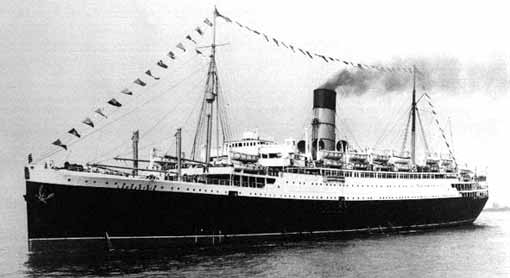
• The Lancastria in peacetime
The ship sank rapidly and according to the
estimate of the Captain, only around 2500 of those on board
were saved. Owing to the scale of the tragedy, Winston Churchill
forbade publication of the news in the interests of public
morale, and hence the story of the Lancastria has never been
generally known, although it is Britain's worst maritime disaster.
Two destroyers nearby, the HMS Havelock and the HMS Highlander,
began taking survivors aboard as did many merchant ships present,
such as the Glenaffaric, the Oronsay, the Fabian and the John
Holt. Many of the survivors were seriously wounded.
The New York Times broke the story, printing
some of the dramatic pictures of the disaster and was soon
afterwards taken up by the British press. The official report
however is still sealed until the year 2040 under the Official
Secrets Act. If it could be proved that the Captain
Rudolph Sharpe was ordered by Ministry of Defence Officials
to ignore his maximum load restriction there could be considerable
grounds for compensation claims against the British Government.
Currently the evidence for this remains under lock and key
for another 40 years.
It has been speculated that the primary reason the Official
Report has been supressed is that the Captain
of the Lancastria was instructed to load as many passengers as
possible and to "disregard international law on passenger limits."
It has not been clearly established who gave that instruction..
Given that that order was given however, and
also the fact that some of the survivors and, more
importantly, a significant number of relatives of victims, are
still alive, there could be significant cause for legal
action to be taken against the British authorities should it
ever be established who gave the loading order. Releasing the
documents of the inquiry could lead to significant compensation
being paid out. By 2040, it will be safe to assume that
most people directly affected, either through the loss
of a family member, or indeed, survivors affected will
no longer be around.
It is also worth noting the Authorities were
quick to place a D-Notice on the news of the sinking,
suppressing all
information about the disaster. Churchill claimed news would
damage morale, but when Churchill was subsequently asked
after the war why he had not lifted the D-Notice after the
Germans were finally defeated, he claimed he had merely
forgotten to do so.

• Taken from HMS Highlander
Picture courtesy of Mr Clements, Lancastria Association
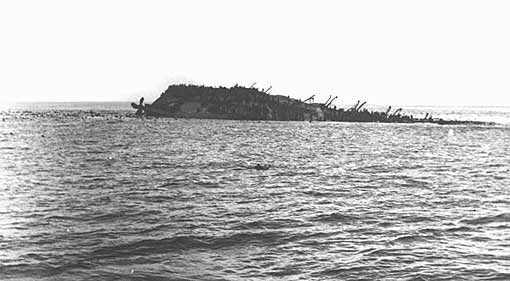
• The Lancastria troopship in
its final movements. Those who managed to
escape overboard were engulfed by huge quantities of leaking
fuel oil
"Latitude 47.09, Longitude
2.20. I shall never forget that position that marks her grave.
Of the five thousand souls aboard her less than half had been
saved;
she sank like a stone and hundreds could not swim."
Harry Grattidge, personal
account
|
|
Lancastria Tragedy - from
The Pioneer magazine March 1947 |
|
The tragedy of the Lancastria is indeed a
memory one could well be without. I took 46 Coy on board her
early on that fatal day and we were, I believe, the first
troops to embark, followed by some 2000 RAF ground staff.
To my regret about 50 per cent of 46 Coy were lost and as
the Company was mostly composed of volunteer tradesmen it
was indeed a loss we could ill afford. I have since been told
that the total loss on that unfortunate ship was 3,300 and
I can well believe it. The great tragedy was that, after two
warning from reconnaissance planes, she was kept at anchor,
with almost 6000 on board, to be bombed like a sitting bird.
Major A G W Tonkin
of 669 POW Wkg 46 Coy, Greenford, Middlesex
|
| Tragedy of the Lancastria - from The Pioneer magazine June
1947 |
|
The sinking of the 16,000 ton Cunard White
Star liner "Lancastria" on the 17th June, 1940,
has been truly described as the greatest sea tragedy of all
time and, to the best of my knowledge, no official record
concerning it has been published. Indeed, although the facts
of her sinking were immediately known to the Germans, the
news of her loss was not made public in this country until
26th July, 1940. At the time of the occurrence I was serving
as the one and only subaltern with 46 Coy A.M.P.C., commanded
by Major D G Carr, and Capt (later Lt. Col, commanding 6 Group)
R.S Sim, MBE., as 2nd in command. We had left Rouen on the
8th June, presumably for evacuation, but we quickly received
instructions to take up a position of defence at le Neubourg,
the defence consisting of 46 Coy. A.M.P.C. plus one French
75 and a couple of machine guns! However we got away from
there and reached Lissieux and eventually arrived at Nantes.
My memories of Nantes are two fold, one being
amazement that the town appeared to be carrying on in the
same manner as if the Germans were still the other side of
the Maginot line and the other a grudging appreciation of
the efficiency of the Base Cashier who succeeded in getting
my account at Cox's debited with 500 francs, which I had drawn
as late at the 14th June ! On the following dat, at about
an hours' notice, we proceeded to an airfield near St. Nazaire
and there we hung about until the next evening when we, at
last, received orders to march to the docks. A tender was
just loading when I brought the Company alongside, only to
be told that it was practically full and there were no more
going out that night. I managed to squeeze 1 Sergeant and
15 O.R.s on board and they at least were saved the catastrophe
of the following day.
We camped out on the quay that night and
were on the first tender in the morning. Many other tenders
quickly followed and it was not long before the Lancastria
had been 5,000 and 6,000 on board. Even so we still remained
at anchor although enemy planes made two reconnaissance flights
over us in the early afternoon. When the actual attack was
made, at about 3.45pm., I had just gone to my cabin which
I was sharing with my O.C., so I have never been able to confirm
or refute the very general impression that the bomb came down
through the ship's funnel. The force of the explosion was
certainly terrific and completely spoilt two very good whiskys
and sodas which I had just poured out ! The ship almost immediately
took a heavy list and on making my way forward I found it
was impossible to do anything as the water was pouring in
and the place was an absolute shambles. The loss of life from
the explosion alone must have been very heavy. I, then made
contact with Capt. Sim (as he then was) and CSM (later Major)
F W Hall. The latter had the bad luck to get a dislocated
ankle, but we were able to get him to the upper deck. By this
time the ship was sinking rapidly (I believe she went down
within about 20 minutes of being hit), and the three of us
took to the water.
I made for an overturned life boat some little
distance away and thanks to the help of a Sergeant, who was
already there, I was able to clamber on to it, but the thick
oil on the water made swimming nearly impossible and doubtless
contributed to the loss of life. The enemy plane was still
hanging around, machine gunning men in the water. Fortunately,
the arrival of a RAF patrol drove him off. I would like to
pay particular tribute to the excellent morale of the men
who were in the water with me for over an hour, and the rescue
work carried out by the small French drifters and our own
destroyers was indeed splendid.
I was eventually picked up by the destroyer
"Highlander" and never shall I forget the wonderful
kindness of the Senior Service. They could not do enough for
us. The total loss on the Lancastria was subsequently given
me by a Staff Officer, who was onboard, as 3,300. In my own
Company the loss was approximately 50 per cent., and I believe
this was fairly general. On returning to England I was asked,
by GHQ., 2nd Echelon, to submit a report of the occurrence
to War Office, and on transferring to my copy I find that
the following A.M.P.C. Coys., in addition to my own, were
said to have been on board : 28, 50, 62, 67, 73 (of which
Major (later Lt.Col.) J H Courage was O.C.) 75 and 108.
In endeavouring to place on record my recollections
of this tragic event I would ask the indulgence of those of
my readers who were also on that ill-fated ship and whose
knowledge and memories are probably far better than my own.
Major A G W Tonkin
The following list of Other Ranks of
the Royal Pioneer Corps who lost their lives owing to the
bombing and sinking of the Lancastria is given as supplied
by War Office - It may not be complete - If anyone knows definitely
of any other Officer or Other Ranks who lost their lives in
this occasion please send details to me.
Details of Officer Casualties are not listed.

| Army No. |
Rank |
Name |
|
Coy |
| to appear shortly... |
|
|
|
|
|
|
Lancastrian Sinking - from
The Pioneer magazine March 1948 |
|
I read with interest of the sinking of the
Lancastria which was sunk off St Nazaire in the Bay of Biscay.
It was on June the 17th about 4.00pm,Monday it was, and she
was under water by 4.20pm, as I was one of the few who stood
on its side almost to the last trying to released a boat from
its bearings, when I noticed L/Cpl Kesson whom I noticed was
amongst the missing. He was clinging to an upturned boat just
before I jumped into the water with a few more pioneers of
the 67th Coy. I read the note of Capt C A Scott of Kingsland,
Newtown, Mon., dated 19 Sept 1947. At time of the Lancastria
he was a Lieutenant in the 67th Company. He mentions that
he last saw Sgt Thompson in the ship's canteen, well Sir,
I saw him sitting on the side of the ship as she lay before
going under, also was Cpl Butcher of the 67th and a Private
Page, who died, I believe on Wednesday morning in the hospital,
I was in at St Nazaire. I also saw two more of our Company,
but sorry to say I have forgotten their names, one was the
store-keepers assistant, the other one a private from Mablethorpe.
As it is so long ago I cannot remember their
names which I know would be of great help to you. I know they
are both dead as one tried to cling hold of the cabin door
to which I was clinging to with a boy of the ship's crew.
I helped him to get with some of his mates who were sitting
on the keel of the upturned boat, after which I was picked
up by a small fishing boat taking back men to docks at St
Nazaire. I was afterwards taken to the civilian hospital worked
by Nuns. It was June the 21st, 1940, when I and ten other
ranks of Buffs and Manchesters and a Belgian woman were taken
on board a British cruiser and landed at Plymouth the following
day. We arrived at a military hospital there for several weeks
treatment. I hope to give more information in the future,
when I can come across some of my old comrades.
Cpl A Pemberton
Pioneer Corps
|
|
Lancastria Survivors Re-union - from
The Pioneer magazine September 1951 |
|
Of the many service reunions that are held
it would be difficult to find one with such poigant memories
as that commemorating so great a tragedy as the bombing and
sinking of the S.S. Lancastria, off St Nazaire on the 17th
June 1940. Coming as it did, very soon after Dunkirk, it has
never excited any great comment either from the Press or the
BBC in spite of the fact that the loss of life was in the
region of 3,300, and thus becomes the greatest sea disaster
of all time. Incidentally, a list of about 400 other ranks
of the Royal Pioneer Corps who lost their lives appeared in
the magazine in June 1947, following an account I then wrote
of the disaster.
To mark the 11th Anniversary nearly a hundred
of the survivors mustered on the Horse Guards Parade and,
headed by a Band and Guard of the Streatham Unit, No 324 Sea
Cadet Group, marched to the Cenotaph where a wreath was placed
by Lt Col Goodwin. A service conducted by the Rev E Wilson
Carlile B.D., with a choir kindly provided by the Church Army,
included a special prayer and the beautiful hymn, "O
God our help in ages past."
At almost the exact hour that the Lancastria
was sunk the survivors again took to the water, but this time
it was on the firm deck of a Thames pleasure steamer and after
an enjoyable cruise the party were the guests of His Majesty's
Yeomen Warders at the Tower of London, and were personally
welcomed by the Governor, Col. E H Carkeet James, OBE MC.
After a specially organised tour of the Tower a very happy
time was spent at the Wardens Social Club and the survivors
had the great pleasure of meeting once again the Captains
of several of the ships that did such excellent rescue work
when the disaster occurred, including Captain W A Dallmeyer,
DSO., RN who commanded the destroyer HMS Highlander, and to
whom the writer will ever be under a debt of gratitude. The
party were also privileged to witness the unique and picturesque
"Ceremony of the Keys," which had its origin some
700 years ago and has several times been broadcast.
And Lang Syne brought to an end a memorable
day and the greatest credit must be given to Major C V Petit
for his excellent work as honorary organiser.
Major A G W Tonkin,
T.D.
Royal Pioneer Corps
|
|
British War Cemetery - Escoublac
- La Baule, Brittany - from
The Pioneer, September 1957 |
|
During a short holiday in Brittany
this year I took the opportunity of visiting the British War
Cemetary at La Baule. Needless to say the cemetery was in
absolutely first class condition, flowers and close cut grass
reminding one very much of an English garden. There are about
five hundred servicemen buried there including British, Canadian,
New Zealand and Polish airmen and commandoes. But my main
interest was in Lancastria men.
This ship you will recall,
sunk off St Nazaire on 17th June, 1940 when evacuating forces.
There were about 5,000 aboard her and about 2,500 were picked
up by other ships. Of the 2,500 drowned, most were trapped
in the Lancastria and went down with her. A number of bodies
were subsequently washed up on the beaches and were buried
by local people in their village cemetaries. After the war
the French Government gave land for the purpose of bringing
the bodies into one cemetery.
I was unable to find any grave
of a comrade known to me, but I took all the details I could
of members of the Corps whose last resting place is in this
lovely little cemetery and in case others might remember them
and might like to know where they are, I append the list here.
| Army No. |
Rank |
Name |
Date |
Age |
| 13003869 |
Pte. |
G Mills |
17.6.40 |
40 |
| 64682 |
Pte. |
J Ridley |
17.6.40 |
25 |
| 13002413 |
Pte. |
A E Brown |
10.5-10.7.40 |
50 |
| 13004153 |
Pte. |
W O'Neill |
17.6.40 |
28 |
| 13005966 |
Pte. |
H J Chapman |
17.6.40 |
36 |
| 1023063 |
Pte. |
W H Easterbrook |
17.6.40 |
42 |
| 3233186 |
Pte. |
P Langford |
17.6.40 |
41 |
| 13001316 |
Pte. |
H V Potton |
17.6.40 |
43 |
| 2188416 |
Pte. |
T E Smith |
17.6.40 |
33 |
| 13000584 |
Pte. |
P Khan |
17.6.40 |
35 |
| 4381206 |
Cpl. |
H Pattison, M.M. |
17.6.40 |
51 |
| 13005099 |
Pte. |
F Jackson |
17.6.40 |
45 |
| 13005010 |
L/Cpl. |
F G Harrison |
17.6.40 |
42 |
| 13004948 |
Pte. |
S Brook |
17.6.40 |
32 |
| 3179660 |
Pte. |
G A Melvin |
17.6.40 |
41 |
| 1001001 |
Cpl. |
A Cope |
17.6.40 |
40 |
| 13005225 |
Pte. |
A Apetu Larty |
17.6.40 |
43 |
| 2188527 |
Pte. |
B Axcell |
17.6.40 |
35 |
| 101269 |
Pte. |
R Bingham |
17.6.40 |
30 |
| 13001792 |
Pte. |
J Watt |
5.4.40 |
41 |
Major F H Blackburn
Royal Pioneer Corps
|
|
The Sinking of The Lancastria by
Stanley
Scislowski |
|
On Monday, June 17, 1940, the Cunard Liner, Lancastria, pressed
into war service as a troopship was anchored just outside
the harbour of St. Nazaire, France taking on thousands of
British troops in the evacuation of the British Expeditionary
Force threatened with annihilation or being taken in the bag
by the German armies rampaging their way through France. Two
weeks earlier, the last of the British and French troops had
been taken off the beach at Dunkirk in the almost unbelievable
overall evacuation of 335,000 British and French troops by
hundreds of craft of all kinds, from cruisers, destroyers,
ferries, river-boats, and small craft of every conceivable
size, shape and kind.
While France was accepting Hitler’s terms of surrender, the
highways and byways of the Pas de Calais outside the Wehrmacht’s
armoured encircling ring around Dunkirk were crowded with
Regiments of British Infantry and ancillary units streaming
towards St.Nazaire where, they were told, ships were waiting
to rescue them from the gaping jaws of captivity. Nineteen
vessels of varying size and types were either at dockside
or anchored in the open sea outside the harbour loading as
many troops as they could cram aboard. The Lancastria was
one of these ships, a single funnelled vessel of 16,243 tons
whose five decks could accommodate in peacetime close to 2000
passengers, but after being converted to troopship duties
it could, with reasonable comfort take on at least twice that
many. As it turned out, she accepted somewhere between 8000
to 9000, although there have been other estimates that were
well below these figures. Some said it carried no more than
5000 troops, although, according to reliable sources, the
higher numbers are closer to the truth. Amongst this great
crowd of fighting men were 38 civilians, 18 of them, workers
from the Fairey Aviation Corporation, along with a few women
and children.
The evacuation began on Saturday, June 16, with a five mile
queue of men inching forward to board ships either at dockside,
or ferried to ships anchored out in the approaches to the
harbour. Complete hospitals and Convalescent Depots were emptied
to become part of the vast exodus. Loading went on all night
long and through the next day. Tenders motored back and forth
ferrying troops between the dock and the Lancastria and other
ships standing by to take on troops in an urgency to beat
the German Armoured columns racing towards the city. The greater
danger, however, for the present, was the Luftwaffe bombers
circling over the harbour, taking turns in making bombing
and strafing runs at the ships below.
A seven ship convoy, commodored by Capt. H. Fuller aboard
the SS John Holt departed Newport the afternoon of June 16,
bound for St. Nazaire on the rescue mission, entering Quiberon
Bay at 7 a.m. the next morning where the ships were anchored
outside the harbour. About a mile away, another liner, the
Oronsay was also taking on a steady shuttle of troops. Shortly
before the Lancastria was hit, the Oronsay was struck by a
bomb, but sustained only minor damage and little loss of life,
and shortly the ship began moving out and was on its way to
England, its engines labouring under the heavy passenger load
it had taken on.
By four in the afternoon the last soldier had been taken
on board the Lancastria, squeezing himself into the incredible
press of men on the vessel’s open deck because every square
inch of cabin space had long since been filled. The ship was
within minutes of hauling up anchor and swinging about for
the quick run across the Channel to England and safety when
a lone JU 88 twin-engine bomber began its bombing run on the
helpless Lancastria. In the last seconds of its shallow dive,
several Bren gunners aboard the ship opened fire but failed
to drive the plane off. Four bombs plummeted towards the ship,
two hitting the sea nearby, while one smashed through the
dining salon and exploded in a lower deck, and the other,
according to witnesses, went straight down the funnel and
detonated in the engine room, both bombs blowing gaping holes
in the ships sides. They were mortal wounds, the damage so
extensive that the ship sank within fifteen minutes. The shortness
of time it remained afloat trapped most of those in the lower
decks, accounting for the reason why so many men went down
with her. Heavy loss of life also occurred amongst the hundreds
floating around on the sea with and without life-jackets,
on rafts, and clinging to whatever flotsam that they could
latch onto when the enemy planes swept in to machine-gun the
struggling mass of people in the water. The heavy blanket
of bunker oil released from the ship’s fuel tanks also contributed
to the death total.
It had been reported in the Daily Mirror of July 26,1940
that 2,823 had been lost, yet other sources claimed that the
total that went down with the ship or died in the water was
more like 5000. These same sources, namely counts taken by
army officers and ship’s officers as the men filed aboard
had the totals varying between 8000 to 9000 having been taken
aboard. Within a few minutes after the bombs struck the ship
began to list sharply to port and was down by the head, with
troops jumping overboard en masse. With the scarcity of lifejackets,
a high percentage had to go without, and with a good many
being non-swimmers, these unfortunate souls thrashed about
in the water for several minutes before slipping beneath the
surface to drown. Others, who were caught in the suffocating
blanket of bunker oil seeping from the ship’s hold, fought
to free themselves from the sticky mess enveloping them, their
eyes, ears, noses and throats eventually filling up, and in
a matter of minutes they too, gave up the struggle and let
the sea claim them. Those that wore lifejackets floated amidst
the debris of wood deck-chairs, packs, kit bags, bits of uniforms
and all sorts of other flotsam became targets for the bomber
as it swung around and made a low-level machine-gunning attack
on the helpless men. On the second pass, it dropped incendiary
bombs on the thick spread of oil around the ship, the murderous
crew hoping to set it on fire and incinerate them. Fortunately
the bombs failed to ignite the oil. The combustible mass simply
sputtered for a minute or so and went out.
When the bomber peeled off for a third strafing, two men
on a raft must have thought the situation was hopeless and
agreed to end their agony. The one with the revolver, pointed
it at his friend’s head, and then this man was heard to exclaim,
“Fire away!” A shot rang out, and within a second or two another
shot. The man ended his own life.
A short distance away, another drama unfolded. A lifeboat
crowded with survivors drifted into view of a group of people
on a raft. They saw an officer in the front with a revolver
keeping others away by threatening to shoot them. One man
in the water made several grabs at the boat, whereupon the
officer put the gun to the man’s head and fired. The man sank
out of sight. Not four seconds later, the officer himself
was shot from behind. He stiffened, then rolled sideways into
the sea and was gone. Desperation did strange and dreadful
things to people’s minds.
Although it was obvious the vessel would soon sink, there
was little or no panic. But, as one of the lifeboats filled
with women and other civilians was being lowered to the sea,
it got stuck halfway down. One overzealous
member of the Pioneer Corps,
thinking he could free the boat by cutting a rope with his
jack-knife succeeded only in causing the boat to drop at its
prow, throwing the terrified occupants into the sea.
It might be mentioned here the courage of those who, although
they knew they were within minutes of stepping over the threshold
into eternity, raised their voices in song as they stood on
the lowering decks. “Nearer My God To Thee” was not the song
sung on the Lancastria as the doomed passengers on board the
Titanic were supposed to have sung as that great ship was
going down in the icy North Atlantic in 1912. The soon-to-be-drowned
souls on board the Lancaster sang more cheerful tunes, songs
like ‘Roll Out the Barrel’, ‘Hanging Out the Washing on the
Siegfried Line’, and as the end drew nearer, they broke into
‘There’ll Always Be An England’. Closer to the ship’s stern,
another group, their voices clear and unwavering sang, ‘God
Be With You Till We Meet Again’.
Many were the heroic acts that took place in the short fifteen
minutes between the time the bombs hit and the ship’s disappearance
beneath the waves. A lone Bren gunner somewhere unseen on
one of the decks kept popping off short bursts at the German
planes that kept sweeping, its wing-guns lashing out at the
men bobbing about and struggling in the oil-smeared sea. This
brave man, could have, like those around him, made an attempt
to leave the ship to save himself, but he chose to stay at
his weapon even as the water closed in over him. The truly
sad part of this man’s sacrifice was that no one would ever
know his name—a hero who will forever remain unknown.
Fear can sometimes bring about miraculous results, as when
an RAF officer who was about to jump into the water, overheard
a man next to him bewailing the fact that he couldn’t swim.
The officer, cuttingly replied, “Well, now’s your chance to
learn.” Shortly thereafter as the officer treaded water, this
self-same individual who couldn’t swim, went by him like a
torpedo. His stroke, that of an Olympic champion.
Fear can also do strange and awful things to men’s minds.
One panic-stricken man in the water went berserk as he tried
to tear the life-jacket off another man, and then fought to
join the group of six people clinging together in a circle,
three having lifejackets, the others had not. By this means
the ‘haves’ managed to save the ‘have-nots’. But now as the
manic one thrashed and flailed away with his arms trying to
wrench a jacket off one of the group, a fierce struggle ensued.
As one of the group later explained, “Had the fellow been
calm, we could have supported the extra burden. But since
he was a menace to our own hopes of survival, we had to fight
him off, after which he swam over to another man and fought
him for possession of the man’s lifejacket The outcome of
this man’s demented effort to save himself is not known. One
might ask here, “Why is it that some people, on the approach
of doom can face it with stoicism or calm resignation, while
others go into paroxysms of weeping or uncontrollable violence
as the end draws near?” The answer defies conclusion.
Besides the lone Bren gunner who stayed at his post until
the seas closed over him, there were other isolated acts of
heroism going on. Like the naked man covered completely in
black oil who dove time after time into the sea from the safety
of the rescuing ship to bring floundering people to its side
where they could be hauled aboard.
And then there was the poignant scene of a mother, and her
tiny baby being thrown into the water when a lifeboat capsized
crying out to others drifting nearby, “My baby! My baby! Please
find my baby!” Back came the answer, “It’s all right, Ma,
we’ve got her,” as they held her baby well above the water.
As the Lancastria was settling rapidly by the head, ships
nearby—the trawler Cambridgeshire, the destroyers Havelock
and Highlander, the cargo ship John Holt and other ships responded
to the urgency by moving in and pulling survivors out of the
water, many of those picked up out of the water were heavily
covered in oil or suffered acutely from exposure in the cold
water of the Channel. They rescued, as the Daily Mirror reported
2,823 out of a total of close to 8000 passengers that had
been aboard. All others, over 5000 of them went down with
the Lancastria. Exact totals will never be known. Suffice
it to say that the sinking of the Lancastria was the single
greatest marine(not naval) disaster suffered by the British
in WW II, and for the sake of morale at a time when that morale
wavered under the punishing blows of defeat in France, publicity,
through necessity, was minimized. As the war progressed and
other disasters occurred, one upon the other, the loss of
the Lancastria was soon forgotten, except in the many households
throughout the British Isles where the loss of a loved one
would never be forgotten.
Stanley Scislowski
13-08-2001
(reproduced
with kind permission - thanks Stanley)
|
|
Pioneer Accounts - from
The Forgotten Tragedy by Brian James Crabb |
|
Lieutenant R Haynes, AMPC, narrlow avoided
death. He had been standing two yeards from the hatch when
the explosion occurred and was thrown to the deck. He relates
his story: "As I lay there waiting for the debris to
fall I began to pray. It must have been only seconds, but
it seemed like ages and I prayed like hell. Then I felt a
blow against my back. A rifle had hit me. I was relieved it
was not a Bren gun !
Lieutenant R Haynes
AMPC
 |
A company sergeant of the Auxiliary Military
Pioneer Corps, who had been allocated to one of the holds,
related his story: "I gave the order to man the hosepipes,
for smoke was coming in the hatch. It was impossible to obey,
because the troops were jammed so tight in the alleyways.
Just then the ship gave a sudden lurch to port until she was
listing at an angle of 45 degrees. We were thrown off our
feet. From the bridge came the order: "Every man for
himself," and I chucked hatchboards over the side to
act as rafts when we got into the water. By this time the
ship was beginning to sink and her propellers were right out
of the sea... as two of the lifeboats were dropping down the
towering side of the Lancastria, they capsized. One had about
120 people on board including two French women and two children,
aged about five. They were flung into the water. One woman
flung her baby into the water and dived in after it; she was
a strong swimmer, and after picking up the child she made
off to one of the lifeboats...
Forward was a soldier with a Bren gun rattling
away with all he'd got. He stuck it out even when the water
was up to his waist. His gun was silenced only when he was
washed away from it. A grand lat. I hope he was saved. Just
before the ship capsized and went down, some of our men...
(laughed in the face of death) (we called ourselves The Thin
Red Line) and scrambled on to her uppermost side. There they
stood, ... (with an immaculately dressed British officer coolly
smoking a cigarette) knowing that they had no chance. They
went down like brave men, singing 'Roll out the Barrel...
(let's have a barrel of fun) !
Company Sergeant
AMPC
A sergeant of the AMPC had been in the stokehold
during the attack. Tracing his way into the accommodation
area he rushed to the side of a French woman and her eight
year old child. He assisted them up a companionway, which
was hampered by escaping steam from fractured pipes. To avoid
getting burnt they held handkerchiefs over their faces. He
eventually got them aboard a lifeboat and was then told to
join them.
Sergeant
AMPC
|
|
Photographs of The Lancastria by
Frank Clements |
| In 1940 Frank Clements was a 30-year-old
volunteer onboard the HMS Highlander, a destroyer that was being
used to ferry troops from Saint-Nazaire harbour to the anchored
Lancastria. His pictures tell the tragic story of the Lancastria
and are the only photographs of the stricken vessel's final
moments. |
|
Navy personnel were not allowed to
take cameras on board but as a volunteer in the naval stores,
he managed to keep his camera with him wherever he went. His
younger brother Arthur Clements, now 84, says: "He was
a photographic nut. He took thousands of 'prints' as he called
them of his war experiences all over the world." But
as well as taking pictures he also played his part in the
rescue operation, downing his camera to help survivors. "He
did all he could," recalls his brother. "He even
pulled a little baby out of the sea."
He talked afterwards about the soldiers who
had been ordered not to abandon
their rifles. He watched them drowning under the weight of
their heavy weapons and said he shouted at them to let go
of them. Sadly many didn't listen." |
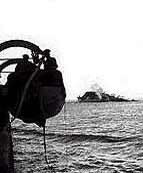 |
|
Valerie Billings of the Portsmouth Naval
Museum, who interviewed Mr Clements before his death in 1999,
says it was an enormous stroke of luck that he was able to
take the photographs. "It was an amazing coincidence,
firstly that he had a camera on board at all. Secondly, he
had no film for the camera but happened to meet a sailor on
his way to Saint-Nazaire who swapped him a camera film for
a pair of socks from the NAAFI stores and it was with that
film that he took these pictures." |
|
When he returned to the UK, Mr Clements handed over prints
of his photographs
to a man he met in a pub. The pictures were then sold to the
press, although Mr Clements never made any money from them.
The pictures have now become invaluable to the Lancastria
Association in their campaign to make the story of the doomed
ship more widely known. The Association's Robert Miller, who
headed out on a pilgrimage to Saint-Nazaire on
the 60th anniversary of the disaster, says: "The photographs
are extremely important, priceless in fact, to us and to the
whole fabric of the story." "If it wasn't for the
fact that Frank Clements was on board the Highlander and that
he was a keen photographer, there would be no pictures of
the disaster whatsoever." |
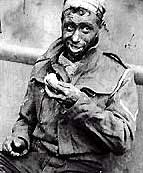 |
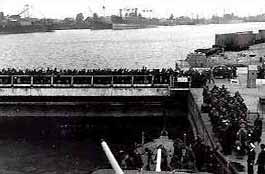 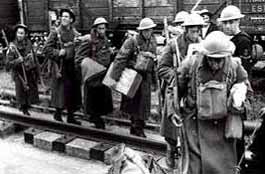
• Battle-weary troops wait •
They were loaded onto navy destroyers and
on docks at Saint-Nazaire ferried
to the giant troopship HMT Lancastria
|
|
 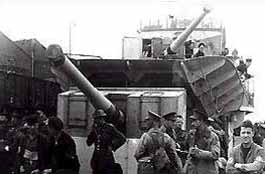
• Estimated 6000 servicemen, plus a number of •
Boats like the HMS Highlander loaded people
civilian woman and children were taken onboard
onto the Lancastria until it was
overflowing
|
|
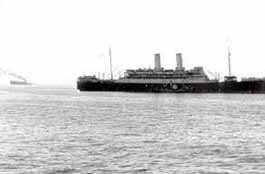 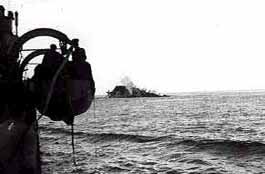
• At 1400hrs the anchored Lancastria, seen here •
At 1557 she was struck by bombs below the
in background, was attacked by enemy aircraft waterline
which ruptured the boat's fuel tanks
|
|
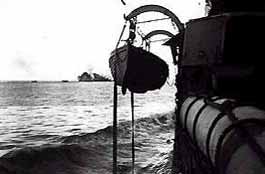 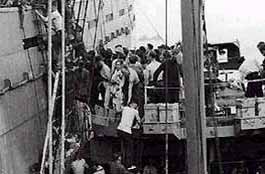
• Others were burnt as oil was ignited by flares •
Rescue boats picked up survivors under fire
from the few lifeboats. By 1615hrs it hadsunk. from
enemy aircraft.
|
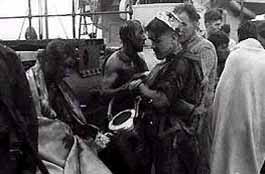 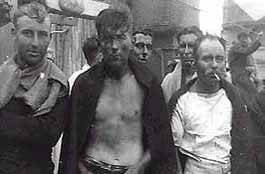
• Exhausted and covered in oil, many were •
Of the estimated 6,000+ people onboard the
loaded onto ships bound for the UK. Lancastria,
less than half survived
|
|
Lancastria Survivors Association |
| After the war the 'Lancastria
Survivors Association' was set up by Major Peter Petit, which
brought together the then-known survivors, however, this Association
lapsed with Major Petit's death. The Association was revived
in its present form in 1980. We meet our objectives by holding
meetings both on a national and a regional basis and by making
pilgrimages to the St Nazaire area, visiting cemeteries where
victims are buried, and the wreck itself.
The membership now includes over 160 survivors of the disaster,
some now living as far away as North America, Africa, and
Australia and New Zealand. The exciting thing is that they
are still finding survivors, some via the Internet. The prime
meeting each year is held on the first Sunday after the 17th
of June at St Katharine Cree Church, Leadenhall Street, in
the City of London. The Annual General Meeting is preceded
by a ceremony at the Merchant Navy memorial on nearby Tower
Hill and is followed by a remembrance service at the church.
Other activities include an annual visit to the National Arboretum
at Alrewas in Staffordshire where Merchant Navy losses in
World War 2 are remembered by a convoy (of trees) headed by
the Lancastria.
In the year 2002 they are making a another pilgrimage to
St Nazaire to mark the 62nd anniversary of the tragedy and
there are visits in the planning stage to the museum at RAF
Digby, in Lincolnshire, which has a section devoted to the
Lancastria, and the Merseyside Maritime Museum in Liverpool
to see the Lancastria display there.
Membership of the Association is now open to any person who
wishes to remember the sacrifices made in, or resulting from,
the action of the 17th of June 1940.Details can be had from
the Association's Secretary:-
Lancastria Survivors Association
Association
Secretary
Robert
Miller
2
Ash Road
Sandwich
Kent
CT13
9JA
Email
the Association
Survivors' stories are printed in The Loss of 'Lancastria'
by J L West (£4.00) and The HMT Lancastria Association
Narratives, (£10.00). Both are available from the Association
:-
Lancastria Survivors Association
Association
Treasurer
Colin
Clarke
14
Coxswain Way
Selsey
Chichester
PO20
0UA
|
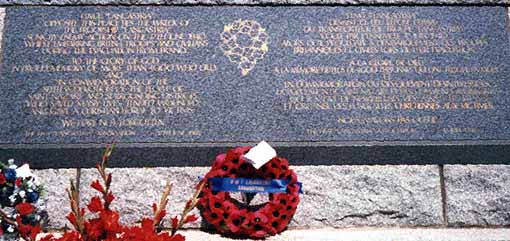
• The Lancastria memorial
on the sea front at St. Nazaire
"Opposite this place lies the wreck of the troopship
Lancastria sunk by enemy action on 17 June 1940 whilst embarking
British troops and civilians during the evacuation of France.
To the glory of God, in proud memory of more than 4,000
who died and in commemoration of the people of Saint Nazaire
and surrounding districts who saved many lives, tended wounded
and gave a Christian burial to victims.
We have not forgotten. HMT ‘Lancastria’ Association, 17
June 1988.’’
|
|
Related Links |
 Lancastria Association of Scotland Lancastria Association of Scotland
 Lancastria
Association Lancastria
Association
|
|
|
|
|
